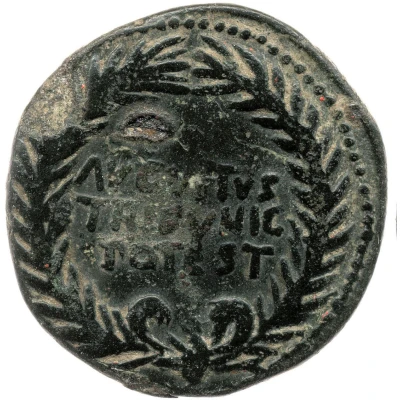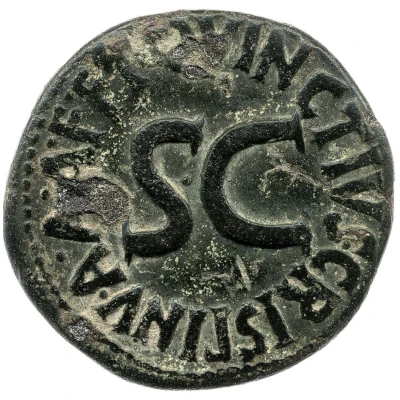


© Classical Numismatic Group, Inc.
Dupondius T CRISPINVS SVLPICIANVS IIIVIR A A A F FS C 18 BC
18 BC year| Bronze | 16.5 g | 33.5 mm |
| Issuer | Rome › Roman Empire (27 BC - 395 AD) |
|---|---|
| Emperor | Augustus (Caius Octavius) (27 BC - 14 AD) |
| Type | Standard circulation coin |
| Year | 18 BC |
| Value | 1 Dupondius = ⅛ Denarius |
| Currency | Denarius, Reform of Augustus (27 BC – AD 215) |
| Composition | Bronze |
| Weight | 16.5 g |
| Diameter | 33.5 mm |
| Shape | Round (irregular) |
| Technique | Hammered |
| Demonetized | Yes |
| Updated | 2024-10-06 |
| Numista | N#247814 |
|---|---|
| Rarity index | 100% |
Reverse
Legend surrounding S C.
Script: Latin
Lettering:
T CRISPINVS SVLPICIANVS IIIVIR A A A F F
S C
Translation:
Titus Crispinus Sulpicianus Triumvir Auro, Argento, Aere, Flando, Feriundo. Senatus Consultum.
Titus [Quinctius] Crispinus Sulpicianus, moneyer (Triumvir Monetalis) for the casting and striking of gold, silver, and bronze coins. Decree of the senate.
Comment
Mass varies: 9.48–33.69 g;Diameter varies: 25–47 mm;
Source: Online Coins of the Roman Empire (OCRE)
Interesting fact
The Dupondius coin features an interesting combination of imagery on its reverse side. It depicts a scene of a triumphal arch, which was a common motif in Roman coinage, but it also includes an image of a caduceus, which is a staff entwined with snakes and wings, typically associated with the Roman god Mercury. This combination of a triumphal arch and a caduceus suggests that the coin may have been issued to commemorate a military victory or triumph, as well as to highlight the Roman Empire's association with trade and commerce, which was often represented by Mercury.



